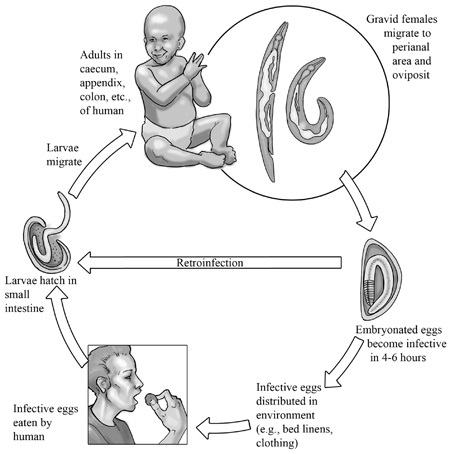Roundworm—Enterobius vermicularis (Pinworms or Seatworms) causes Enterobiasis. The severity of disease depends upon the worm load, since most nematodes cannot multiply in their host. The picture on the right shows what you see on a positive pinworm scotch tape test under the microscope (after staining) and upon an endoscopic rectal exam (right picture):
Note that the adult (white) worms are greatly enlarged. These worms are actually one about a quarter of an inch long and are fairly clear so they are hard to see.
This particular worm is only passed to humans via humans by fecal-oral route. The eggs can also stick to bed sheets or become airborne. Adults mature and settle in the small intestine, colon and cecum. The females sneak out at night and lay eggs around the perianal areas then sneak back into the rectum .
Lifecycle of the Pinworm:
Picture Reference: https://clem.mscd.edu/~churchcy/BIO3270/Images/Nematodes/Enterobius_cycle.htm
Symptoms of Enterobius usually include an itchy anus but they can also cause problems with the gut such as abdominal pain and appendicitis.
Diagnosis is with the Scotch Tape Test. You stick a piece of tape, sticky side to the skin, on the anal area then tape it to a microscope slide which is stained and viewed to find the eggs. The adult female pinworm is about 10 millimeters long, the male pinworm is much smaller. OR you can see it with a lower gastroscopic exam (but that’s quite expensive!)
In the old days, physicians used to tell the parents to sneak into the child’s room at night with a flash light, spread the child’s legs and turn the flash light on to see if they could see the worms coming out of the anus. Gross! Can you imagine how many emotional problems were caused from that ordeal! These days you’d probably be labeled as a pervert!
Treatment Enterobius vermicularis can be treated with several antihelminthic drugs, e.g. pyrantel pamoate, pyrvinium pamoate or mebendazole.
Helpful Links and References:
- Picture of roundworm: https://www.gastrolab.net/pa-160.htm
- Pinworm medication (over-the-counter): https://www.reesechemical.com/pinworm.html

